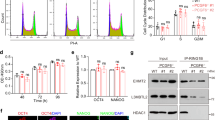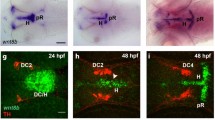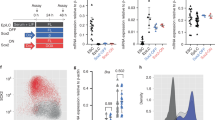Abstract
The generation of neurons from stem cells involves the activity of proneural basic helix-loop-helix (bHLH) proteins, but the mechanism by which these proteins irreversibly commit stem cells to neuronal differentiation is not known. Here we report that expression of the transcription factors Sox1, Sox2 and Sox3 (Sox1–3) is a critical determinant of neurogenesis. Using chick in ovo electroporation, we found that Sox1–3 transcription factors keep neural cells undifferentiated by counteracting the activity of proneural proteins. Conversely, the capacity of proneural bHLH proteins to direct neuronal differentiation critically depends on their ability to suppress Sox1–3 expression in CNS progenitors. These data suggest that the generation of neurons from stem cells depends on the inhibition of Sox1–3 expression by proneural proteins.
This is a preview of subscription content, access via your institution
Access options
Subscribe to this journal
Receive 12 print issues and online access
$209.00 per year
only $17.42 per issue
Buy this article
- Purchase on SpringerLink
- Instant access to full article PDF
Prices may be subject to local taxes which are calculated during checkout






Similar content being viewed by others
References
Bertrand, N., Castro, D.S. & Guillemot, F. Proneural genes and the specification of neural cell types. Nat. Rev. Neurosci. 3, 517–530 (2002).
Kintner, C. Neurogenesis in embryos and in adult neural stem cells. J. Neurosci. 22, 639–643 (2002).
Ma, Q., Kintner, C. & Anderson, D.J. Identification of neurogenin, a vertebrate neuronal determination gene. Cell 87, 43–52 (1996).
Guillemot, F. Vertebrate bHLH genes and the determination of neuronal fates. Exp. Cell Res. 253, 357–364 (1999).
Morrow, E.M., Furukawa, T., Lee, J.E. & Cepko, C.L. NeuroD regulates multiple functions in the developing neural retina in rodent. Development 126, 23–36 (1999).
Farah, M.H. et al. Generation of neurons by transient expression of neural bHLH proteins in mammalian cells. Development 127, 693–702 (2000).
Scardigli, R., Schuurmans, C., Gradwohl, G. & Guillemot, F. Crossregulation between Neurogenin2 and pathways specifying neuronal identity in the spinal cord. Neuron 31, 203–217 (2001).
Davis, R.L. & Turner, D.L. Vertebrate hairy and Enhancer of split related proteins: transcriptional repressors regulating cellular differentiation and embryonic patterning. Oncogene 20, 8342–8357 (2001).
Kageyama, R. & Nakanishi, S. Helix-loop-helix factors in growth and differentiation of the vertebrate nervous system. Curr. Opin. Genet. Dev. 7, 659–665 (1997).
Gradwohl, G., Fode, C. & Guillemot, F. Restricted expression of a novel murine atonal-related bHLH protein in undifferentiated neural precursors. Dev. Biol. 180, 227–241 (1996).
Lo, L., Dormand, E., Greenwood, A. & Anderson, D.J. Comparison of the generic neuronal differentiation and neuron subtype specification functions of mammalian achaete-scute and atonal homologs in cultured neural progenitor cells. Development 129, 1553–1567 (2002).
Kamachi, Y., Uchikawa, M. & Kondoh, H. Pairing SOX off: with partners in the regulation of embryonic development. Trends Genet. 16, 182–187 (2000).
Uwanogho, D. et al. Embryonic expression of the chicken Sox2, Sox3 and Sox11 genes suggests an interactive role in neuronal development. Mech. Dev. 49, 23–36 (1995).
Pevny, L.H., Sockanathan, S., Placzek, M. & Lovell-Badge, R. A role for SOX1 in neural determination. Development 125, 1967–1978 (1998).
Wegner, M. From head to toes: the multiple facets of Sox proteins. Nuc. Acids Res. 27, 1409–1420 (1999).
Stevanovic, M., Lovell-Badge, R., Collignon, J. & Goodfellow, P.N. SOX3 is an X-linked gene related to SRY. Hum. Mol. Genet. 2, 2013–2018 (1993).
Nishiguchi, S., Wood, H., Kondoh, H., Lovell-Badge, R. & Episkopou, V. Sox1 directly regulates the gamma-crystallin genes and is essential for lens development in mice. Genes Dev. 12, 776–781 (1998).
Overton, P., Meadows, L., Urban, J. & Russell, S. Evidence for differential and redundant function of the Sox genes Dichaete and SoxN during CNS development in Drosophila. Development 129, 4219–4228 (2002).
Buescher, M., Hing, F. & Chia, W. Formation of neuroblasts in the embryonic central nervous system of Drosophila melanogaster is controlled by SoxNeuro. Development 129, 4193–4203 (2002).
Yuan, H., Corbi, N., Basilico, C. & Dailey, L. Developmental-specific activity of the FGF-4 enhancer requires the synergistic action of Sox2 and Oct-3. Genes. Dev. 9, 2635–2645 (1995).
Collignon, J. et al. A comparison of the properties of Sox-3 with Sry and two related genes, Sox-1 and Sox-2. Development 122, 509–520 (1996).
Ambrosetti, D.C., Basilico, C. & Dailey, L. Synergistic activation of the fibroblast growth factor 4 enhancer by Sox2 and Oct-3 depends on protein-protein interactions facilitated by a specific spatial arrangement of factor binding sites. Mol. Cell. Biol. 17, 6321–6329 (1997).
Nishimoto, M., Fukushima, A., Okuda, A. & Muramatsu, M. The gene for the embryonic stem cell coactivator UTF1 carries a regulatory element which selectively interacts with a complex composed of Oct-3/4 and Sox-2. Mol. Cell. Biol. 19, 5453–5465 (1999).
Avilion, A. et al. Multipotent cell lineages in early mouse development depend on SOX2 function. Genes Dev. 17, 126–140 (2003).
Roztocil, T., Matter-Sadzinski, L., Alliod, C., Ballivet, M. & Matter, J.M. NeuroM, a neural helix-loop-helix transcription factor, defines a new transition stage in neurogenesis. Development 124, 3263–3272 (1997).
Fode, C. et al. The bHLH protein NEUROGENIN 2 is a determination factor for epibranchial placode-derived sensory neurons. Neuron 20, 483–494 (1998).
Caccamo, D. et al. Immunohistochemistry of a spontaneous murine ovarian teratoma with neuroepithelial differentiation. Neuron-associated beta-tubulin as a marker for primitive neuroepithelium. Lab Invest. 60, 390–398 (1989).
Mullen, R.J., Buck, C.R. & Smith, A.M. NeuN, a neuronal specific nuclear protein in vertebrates. Development 116, 201–211 (1992).
Tsuchida, T. et al. Topographic organization of embryonic motor neurons defined by expression of LIM homeobox genes. Cell 79, 957–970 (1994).
Briscoe, J. & Ericson, J. Specification of neuronal fates in the ventral neural tube. Curr. Opin. Neurobiol. 11, 43–49 (2001).
Westendorf, J.M., Rao, P.N. & Gerace, L. Cloning of cDNAs for M-phase phosphoproteins recognized by the MPM2 monoclonal antibody and determination of the phosphorylated epitope. Proc Natl. Acad. Sci. USA 91, 714–718 (1994).
Kelman, Z. PCNA: structure, functions and interaction. Oncogene 14, 629–640 (1997).
Botquin, V. et al. New POU dimer configuration mediates antagonistic control of an osteopontin preimplantation enhancer by Oct-4 and Sox-2. Genes Dev. 12, 2073–2090 (1998).
Berk, A.J. et al. Mechanisms of viral activators. Cold Spring Harb. Symp. Quant. Biol. 63, 243–252 (1998).
Smith, S.T. & Jaynes, J.B. A conserved region of engrailed, shared among all en-, gsc-, NK1, NK2-, and msh-class homeoproteins, mediates active transcriptional repression in vivo. Development 122, 3141–3150 (1996).
Muhr, J., Andersson, E., Persson, M., Jessell, T.M. & Ericson, J. Groucho-mediated transcriptional repression establishes progenitor cell pattern and neuronal fate in the ventral neural tube. Cell 104, 861–873 (2001).
Mizuguchi, R. et al. Combinatorial roles of olig2 and neurogenin2 in the coordinated induction of pan-neuronal and subtype-specific properties of motoneurons. Neuron 31, 757–771 (2001).
Novitch, B.G., Chen, A.I. & Jessell, T.M. Coordinate regulation of motor neuron subtype identity and pan-neuronal properties by the bHLH repressor Olig2. Neuron 31, 773–789 (2001).
Takebayashi, K. et al. Conversion of ectoderm into a neural fate by ATH-3, a vertebrate basic helix-loop-helix gene homologous to Drosophila proneural gene atonal. EMBO J. 16, 384–395 (1997).
Morgan, B.A. & Fekete, D.M. Manipulating gene expression with replication-competent retroviruses. Methods Cell Biol. 51, 185–218 (1996).
Jouve, C. et al. Notch signaling is required for cyclic expression of the hairy-like gene HES1 in presomitic mesoderm. Development 127, 1421–1429 (2000).
Kim, J., Lo, L., Dormand, E. & Anderson, D. Sox10 maintains multipotency and inhibits neuronal differentiation of neural crest stem cells. Neuron 38, 17–31 (2003).
Koyano-Nakagawa, N. et al. Hes6 acts in a positive feedback loop with the neurogenins to promote neuronal differentiation. Development 127, 4203–4216 (2000).
Yokota, Y. Id and development. Oncogene 20, 8290–8298 (2001).
Zappone, M. et al. Sox2 regulatory sequences direct expression of a (beta)-geo transgene to telencephalic neural stem cells and precursors of the mouse embryo, revealing regionalization of gene expression in CNS stem cells. Development 127, 2367–2382 (2000).
Wilson, S.I., Graziano, E., Harland, R., Jessell, T.M. & Edlund, T. An early requirement for FGF signalling in the acquisition of neural cell fate in the chick embryo. Curr. Biol. 10, 421–429 (2000).
Jasoni, C.L., Walker, M.B., Morris, M.D. & Reh, T.A. A chicken achaete-scute homolog (CASH-1) is expressed in a temporally and spatially discrete manner in the developing nervous system. Development 120, 769–783 (1994).
Kamachi, Y., Uchikawa, M., Collignon, J., Lovell-Badge, R. & Kondoh, H. Involvement of Sox1, 2 and 3 in the early and subsequent molecular events of lens induction. Development 125, 2521–2532 (1998).
Perez, S.E., Rebelo, S. & Anderson, D.J. Early specification of sensory neuron fate revealed by expression and function of neurogenins in the chick embryo. Development 126, 1715–1728 (1999).
Briscoe, J., Pierani, A., Jessell, T.M. & Ericson, J. A homeodomain protein code specifies progenitor cell identity and neuronal fate in the ventral neural tube. Cell 101, 435–445 (2000).
Acknowledgements
We thank M. Uchikawa for Sox1–3 chick cDNA and T. Reh for Cash1 cDNA. We are grateful to P. Bailey, T. Edlund, J. Ericson, U. Lendahl, T. Perlmann and S. Wilson for discussions and comments on the manuscript. J.M. is supported by the Swedish Natural Research Council, the Swedish Foundation for Strategic Research and the Ludwig Institute of Cancer Research.
Author information
Authors and Affiliations
Corresponding author
Ethics declarations
Competing interests
The authors declare no competing financial interests.
Supplementary information
Supplementary Fig. 1.
Regulation of c-Hairy1 and c-Hes5 expression by Ngn2 and Sox3. (a-c) Misexpression of Ngn2 (a) increased the expression of c-Hairy1 (b) in a fraction of the transfected cell, whereas c-Hes5 expression was markedly upregulated throughout the Ngn2 electroporated side (c). Embryos were analyzed 10 h after electroporation. (d-f) The expression of c-Hairy1 was similar in the Sox3 electroporated side compared to the control side (d and e), whereas the expression level of c-Hes5 was slightly decreased in Sox3 transfected cells (f). Embryos were analyzed 44 h after electroporation. (JPG 54 kb)
Rights and permissions
About this article
Cite this article
Bylund, M., Andersson, E., Novitch, B. et al. Vertebrate neurogenesis is counteracted by Sox1–3 activity. Nat Neurosci 6, 1162–1168 (2003). https://doi.org/10.1038/nn1131
Received:
Accepted:
Published:
Issue Date:
DOI: https://doi.org/10.1038/nn1131
This article is cited by
-
Post-transcriptional control of a stemness signature by RNA-binding protein MEX3A regulates murine adult neurogenesis
Nature Communications (2023)
-
NvPrdm14d-expressing neural progenitor cells contribute to non-ectodermal neurogenesis in Nematostella vectensis
Nature Communications (2023)
-
Distinct gene expression patterns of SOX2 and SOX2OT variants in different types of brain tumours
Journal of Genetics (2023)
-
The rates of adult neurogenesis and oligodendrogenesis are linked to cell cycle regulation through p27-dependent gene repression of SOX2
Cellular and Molecular Life Sciences (2023)
-
Toll-like receptors 2 and 4 differentially regulate the self-renewal and differentiation of spinal cord neural precursor cells
Stem Cell Research & Therapy (2022)



